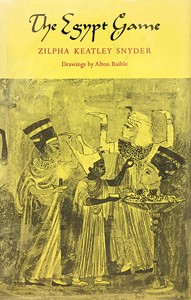 |
| The Egypt Game, 1st ed. |
Martin, Cathlena. “Role Playing in Children’s Literature. Zilpha Keatley Snyder and The Egypt Game.” American Journal of Play 10, no. 2 (2018): 208–28.
Gaming scholar Cathlena Martin is demonstrating how The Egypt Game (1967), a famously acclaimed children novel by Zilpha Keatley Snyder, preceded (and maybe influenced) the role-playing gameplay designs of Dungeons & Dragons (1974). Through the TRPG elements of world building, collaboration, role playing and immersion, she is showing how :
« Snyder codifies in her fiction and presents to young readers is a game in which a player assumes the identity of a character in a fictional setting. (...) [the players] do voluntarily create unnecessary obstacles and attempt to overcome them when they play their Egypt Game. To use computer game terminology, it is a game that resides in an open world or sandbox state of immersive creativity, which means it offers more freedom of choice than the usual linear structures of game play. And it is a game that includes rules the players agreed to bring enacted via role playing.» (p. 225-226)
Moreover, the novel is also an invitation to design and play your own game :
« As the children create their game, they model role playing for readers. This children’s novel is not merely an escape, but also a guidebook, establishing possibilities for other children to read about and enact. (...) when you read The Egypt Game you are being shown possibilities for role playing that you can perform whether in a playground, in an abandoned lot, around a table, or at a computer. » (p. 226)
No comments:
Post a Comment